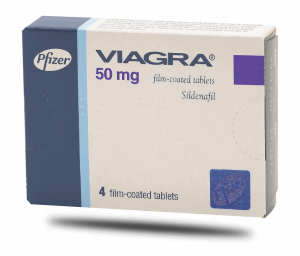How Effective Is Viagra?
Viagra is one of the treatments for erectile dysfunction available for sale here at Mens Pharmacy. To help our clients understand their medications and medical conditions, we’ve written a series of articles on our blog that will provide further information about different conditions and medications.
This article is about the effectiveness of Viagra. We’ll cover what Viagra is, what it is used for, the mechanism of action and what the results from clinical trials say about the effectiveness of Viagra.
What is Viagra?
Viagra is the brand name for a medication known as Sildenafil. It belongs to the pharmacotherapeutic group known as Urologicals.
Each film coated tablet contains sildenafil citrate equivalent to 25, 50 or 100 mg of sildenafil. Viagra (Sildenafil) tablets are blue rounded diamond-shaped tablets, marked with “PFIZER” on one side and “VGR 25, 50 or 100” on the other.
The other substance (excipient) with no known effect in each film coated Viagra (Sildenafil) tablet is lactose. VIAGRA 25 mg film-coated tablets contain 0.834 mg lactose (as monohydrate), VIAGRA 50 mg film-coated tablets contain 1.667 mg lactose (as monohydrate) and VIAGRA 100 mg film-coated tablets containing 3.334 mg lactose (as monohydrate).
The other substances (excipients) in each Viagra (Sildenafil) tablet, that are inactive, include:
Tablet core:
- microcrystalline cellulose
- calcium hydrogen phosphate (anhydrous)
- croscarmellose sodium
- magnesium stearate
Film coat:
- hypromellose
- titanium dioxide (E171)
- lactose monohydrate
- triacetin
- indigo carmine aluminium lake (E132)
The legal category for Viagra (Sildenafil) is POM. This means that this medication is a prescription only medicine and it can only be supplied or sold according to the instructions in a prescription issued by a duly qualified and registered doctor or non-medical prescriber.
You should not buy this or any other prescription-only medication without first speaking to a duly qualified and registered healthcare professional like a doctor or non-medical prescriber.
Click HERE to View Viagra Prices > >
What is Viagra used for?
Sildenafil is indicated for the treatment of Erectile Dysfunction, Digital Ulcers (associated with systemic sclerosis) and Pulmonary Arterial Hypertension.
Treatment for Pulmonary Arterial Hypertension with Sildenafil can only be initiated under the supervision of a specialist clinician.
Please note that the brand Viagra is indicated for the treatment of Erectile Dysfunction only. For it to be effective as a treatment for Erectile Dysfunction, sexual stimulation is needed.
What is the mechanism of action Viagra?
Viagra (Sildenafil) is an oral therapy for erectile dysfunction. In the natural setting, i.e. when there is sexual stimulation, Viagra (Sildenafil) restores impaired erectile function by increasing blood flow to the penis.
The physiological mechanism responsible for the erection of the penis involves the release of nitric oxide (NO) in the corpus cavernosum during sexual stimulation. Nitric oxide then activates the enzyme guanylate cyclase, which results in increased levels of cyclic guanosine monophosphate (cGMP), producing smooth muscle relaxation in the corpus cavernosum and allowing inflow of blood.
Viagra (Sildenafil) is a potent and selective inhibitor of cGMP specific phosphodiesterase type 5 (PDE5) in the corpus cavernosum, where PDE5 is responsible for degradation of cGMP. Viagra (Sildenafil) has a peripheral site of action on erections. Viagra (Sildenafil) does not have a direct relaxant effect on isolated human corpus cavernosum but it potently enhances the relaxant effect of NO on this tissue. When the NO/cGMP pathway is activated, as occurs when there is sexual stimulation, inhibition of PDE5 by Viagra (Sildenafil) leads to increased corpus cavernosum levels of cGMP. Therefore, sexual stimulation is essential for sildenafil to produce its intended beneficial pharmacological effects.
Pharmacodynamic effects
In vitro studies have shown that Viagra (Sildenafil) is selective for PDE5, which is involved in the erection process. Its effect is more potent on PDE5 than on other known phosphodiesterases. There is a 10-fold selectivity over PDE6 which is involved in the phototransduction pathway in the retina. At maximum recommended doses, there is an 80-fold selectivity over PDE1, and over 700-fold over PDE 2, 3, 4, 7, 8, 9, 10 and 11. Viagra (Sildenafil) has greater than 4,000-fold selectivity for PDE5 over PDE3, the cAMP-specific phosphodiesterase isoform involved in the control of cardiac contractility.
Absorption
Sildenafil is rapidly absorbed after being orally ingested. Maximum observed plasma concentrations are reached within 30 minutes to 120 minutes (median 60 minutes) of oral dosing in the fasted state. The mean absolute oral bioavailability is 41% (range 25-63%). After oral dosing of sildenafil AUC and Cmax increase in proportion with dose over the recommended dose range (25-100 mg).
When sildenafil is taken with food, the rate of absorption is reduced with a mean delay in Tmax of 60 minutes and a mean reduction in Cmax of 29%

How effective is Viagra?
According to the Marketing Authorisation holder for Viagra (Sildenafil), two clinical studies were specifically designed to assess the time window after dosing during which Viagra (Sildenafil) could produce an erection in response to sexual stimulation.
In a penile plethysmography (RigiScan) study of fasted patients, the median time to onset for those who obtained erections of 60% rigidity (enough for sexual intercourse) was 25 minutes (range 12-37 minutes) on Viagra (Sildenafil). In a separate RigiScan study, Viagra (Sildenafil) was still able to produce an erection in response to sexual stimulation 4-5 hours post-dose.
Viagra (Sildenafil) causes mild and transient decreases in blood pressure which, in most cases, do not translate into clinical effects. The mean maximum decreases in supine systolic blood pressure following 100 mg oral dosing of sildenafil were 8.4 mmHg. The corresponding change in supine diastolic blood pressure was 5.5 mmHg. These decreases in blood pressure are consistent with the vasodilatory effects of sildenafil, probably due to increased cGMP levels in vascular smooth muscle. Single oral doses of sildenafil up to 100 mg in healthy volunteers produced no clinically relevant effects on ECG.
In a study of the hemodynamic effects of a single oral 100 mg dose of Viagra (Sildenafil) in 14 patients with severe coronary artery disease (CAD) (>70% stenosis of at least one coronary artery), the mean resting systolic and diastolic blood pressures decreased by 7% and 6% respectively compared to the baseline. Mean pulmonary systolic blood pressure also decreased by 9%. Viagra (Sildenafil) showed no effect on cardiac output and did not impair blood flow through the stenosed coronary arteries.
A double-blind, placebo-controlled exercise stress trial evaluated 144 patients with erectile dysfunction and chronic stable angina who regularly received anti-anginal medicinal products (except nitrates). The results demonstrated no clinically relevant differences between Viagra (Sildenafil) and the placebo in time to limiting angina.
Mild and transient differences in colour discrimination (blue/green) were detected in some subjects using the Farnsworth-Munsell 100 hue test at 1 hour following a 100 mg dose. However, no effects were evident after 2 hours post-dose. The postulated mechanism for this change in colour discrimination is related to inhibition of PDE6, which is involved in the phototransduction cascade of the retina. Sildenafil has no effect on visual acuity or contrast sensitivity.
In a small size placebo-controlled study of patients with documented early age-related macular degeneration (n=9), Viagra (Sildenafil) (single dose, 100 mg) demonstrated no significant changes in any of the visual tests conducted (visual acuity, Amsler grid, colour discrimination simulated traffic light, Humphrey perimeter and photostress).
There was no effect on sperm motility or morphology after single 100 mg oral doses of Viagra (Sildenafil) in healthy volunteers.
Further information on clinical trials
In the clinical trials conducted, Viagra (Sildenafil) was administered to well over 8000 patients aged 19 – 87 years. The following patient groups were represented: elderly patients (19.9%), patients with hypertension (30.9%), patients with diabetes mellitus (20.3%), patients with ischaemic heart disease (5.8%), patients with hyperlipidaemia (19.8%), patients with spinal cord injury (0.6%), patients depression (5.2%), patients with transurethral resection of the prostate (3.7%) and patients with radical prostatectomy (3.3%).
The following groups were not well represented or excluded from clinical trials: patients with pelvic surgery, patients post-radiotherapy, patients with severe renal or hepatic impairment and patients with certain cardiovascular conditions.
In fixed-dose studies, the proportions of patients who reported that treatment with Viagra (Sildenafil) improved their erections were 62% (25 mg), 74% (50 mg) and 82% (100 mg) compared to 25% on placebo. In controlled clinical trials, the discontinuation rate due to Viagra (Sildenafil) was low and similar to placebo.
Across all the clinical trials conducted, the proportion of patients who reported an improvement whilst taking Viagra (Sildenafil) was as follows: psychogenic erectile dysfunction (84%), mixed erectile dysfunction (77%), organic erectile dysfunction (68%), elderly (67%), diabetes mellitus (59%), ischaemic heart disease (69%), hypertension (68%), TURP (61%), radical prostatectomy (43%), spinal cord injury (83%), depression (75%). The safety and efficacy of sildenafil were maintained in long-term studies.
Is there anything else I need to know about Viagra?
For Viagra (Sildenafil) to be effective as a treatment for Erectile Dysfunction, sexual stimulation is required.
Physical examination should be undertaken to diagnose erectile dysfunction and determine potential underlying causes before pharmacological treatment is considered.
Should you get an erection that lasted longer than 4 hours, you need to seek urgent medical assistance. This is known as priapism. If priapism is not treated immediately, it may lead to penile tissue damage. This, in turn, could lead to a permanent loss in potency.
Should you develop any sudden visual defects, you should stop taking Viagra (Sildenafil) and speak to your prescriber or other health care professionals immediately.
Viagra (Sildenafil) contains lactose, it should not be taken by men with rare hereditary problems of galactose intolerance, Lapp lactase deficiency or glucose-galactose malabsorption.
Viagra (Sildenafil) is not indicated for use by women or anyone under the age of 18 years.
Dizziness and altered vision have been reported in clinical trials with Viagra (Sildenafil). Thus, you need to be aware of how you react to VIAGRA (Sildenafil), before driving or operating any machinery.
Whilst Sildenafil may be used as a treatment for Digital Ulcers (associated with systemic sclerosis), this is not a licensed indication.
Sildenafil is available under the brand name, Viagra. It is also available as generic Sildenafil.
***
If you would like more information about Viagra (Sildenafil), please click here to fill out our contact form. Alternatively, you may call us on 0161 707 6800
Should you need urgent medical assistance, please dial 999.
If you would like to speak with our in-house doctor about getting Viagra (Sildenafil), please click here to start your remote consultation. Make sure you provide as much detail as you can about your health and any medications you take.
The onset of effect of Sildenafil may be delayed if taken with food.
Click HERE to View Viagra Prices > >
References
- https://bnf.nice.org.uk/drug/sildenafil.html
- https://bnf.nice.org.uk/drug/sildenafil.html#indicationsAndDoses
- https://www.medicines.org.uk/emc/product/7978#PHARMACOLOGICAL_PROPS
- https://www.medicines.org.uk/emc/product/7978#PHARMACOKINETIC_PROPS
- https://www.medicines.org.uk/emc/product/7978#EXCIPIENTS
- https://www.medicines.org.uk/emc/product/7978#INDICATIONS
- https://www.medicines.org.uk/emc/product/7978#PHARMACODYNAMIC_PROPS
- https://www.medicines.org.uk/emc/product/7978#CLINICAL_PRECAUTIONS
- https://www.medicines.org.uk/emc/product/7978#MACHINEOPS
- https://bnf.nice.org.uk/drug/sildenafil.html#unlicensedUse
- https://bnf.nice.org.uk/drug/sildenafil.html#patientAndCarerAdvice
Mens Pharmacy is not liable for the currency or accuracy of the information contained in this blog post. For specific information about your personal medical condition, please contact our doctors or pharmacists for advice on [email protected].

